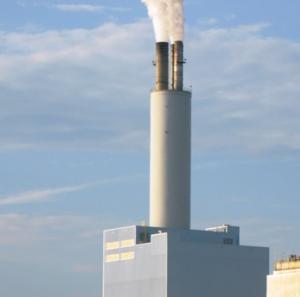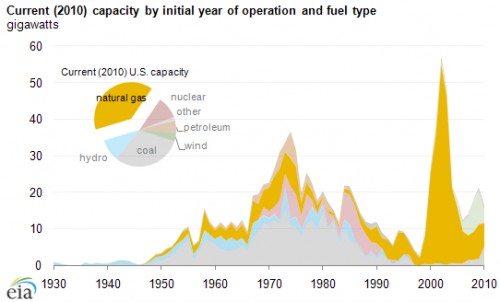
Unable to compete against cheaper natural gas power plants, AES Cayuga, a coal-fired power plant on Ohio's Cayuga Lake's eastern shore, filed for bankruptcy at the end of 2011. This was another example of a US energy sector quaking from drastically lowered natural gas prices. And as more uncompetitive coal plants close, it could ultimately lead to a halving of emissions from parts of power system that still rely on fossil fuel, according to Tim Wortsall, a Forbes energy blogger. So, in the gas vs. coal debate, it becomes easy to see gas as a useful short-medium term option, while renewable energy is the most carbon-efficient long- term solution. The amount of natural gas used for electric power blew past residential use in 2003 and exceeded industry use in 2009. Overall, these changes have been picking up speed as the price for natural gas has dropped. With the trend accelerating and expanding faster than any other sector, electric power is now the largest natural gas-consuming sector. Recently an Ohio blooger conveyed what he had read in a local newspaper article about the AES Cayuga shutdown:
With natural gas prices undercutting the cost of coal, the AES Cayuga power plant in Lansing has not produced electricity since early March. "Right now, with prices where they are, we're not economically viable," AES Cayuga Plant Manager Jerry Goodenough said. The price of natural gas would need to nearly double for the plant to regain economic viability, according to Goodenough. "If gas is trading at $1.90 or $2 per million BTU, and coal is trading at $4 per million BTU, a coal plant would need to get enough from its energy bid to recover for a $4 price, and gas is only $2," he said.
Ok, so more gas-fired plants will be fired-up than coal after the costs are crunched. And, since gas is also more efficient than coal, for whatever number of BTUs going into a plant, we get more electricity in return. So the benefits increase with every new gas-powered plant constructed. Serendipitously, this has been a period of rapid gas power plant construction, with nearly 237 GW of natural gas-fired generation capacity added between 2000 and 2010. At the end of 2010, natural gas-fired generators constituted 39% of the nation's total electric generation capacity, representing 81% of total power construction over that period. See the dramatic EIA graph below:

Because the share of U.S. power generation fueled by natural gas is projected to rise from 24.8% in 2011 to 27.1% this year, and coal is expected to drop, this will mean lower CO2 emissions. Added to the efficiencies of the changing fuel mix, the CO2 emissions from natural gas combined cycle plants (the most technologically sophisticated) are reduced compared to burning coal, given the same power output because of the higher heat content of natural gas, the lower carbon intensity of gas relative to coal, and the higher overall efficiency of a NGCC plant relative to a coal-fired plant. Tim Wortsall says increased natural gas use should also effect the debate about carbon sequestration:
Clean gas is an awful lot easier to achieve than clean coal. It's much, much, easier to strip the C out of CH4 before combustion than it is to collect, cool and compress CO2 from coal after combustion.
So a move to gas would be at least a step towards that desired low- to no-carbon emission electricity generation system.



Comments
Fascinating article! Where did you get the figure from the EIA? I would like to use that in a presentation sometime. This really shows how quickly (or slowly - it's on the order of a decade) a free-market economic incentive can dramatically shift the energy use of our country. I wonder if/when biomass processing technology becomes efficient enough for biofuels to beat the price of petroleum, we'd see such a dramatic shift.
Thanks, here is a link to the EIA article: <a href="http://www.eia.gov/todayinenergy/detail.cfm?id=6290#" rel="nofollow">http://www.eia.gov/todayinenergy/detail.cfm?id=62...</a> and the graphic <a href="http://www.eia.gov/todayinenergy/detail.cfm?id=2070" rel="nofollow">http://www.eia.gov/todayinenergy/detail.cfm?id=20...</a> Hope these help. Kent
Glad you enjoyed the article. Interesting technological developments coming. Article coming soon about realtime 3D field monitoring at shale gas and oil plays. Big Data will also be highlighted in overview of Big Oil's push into data centers and remote well monitoring. Kent